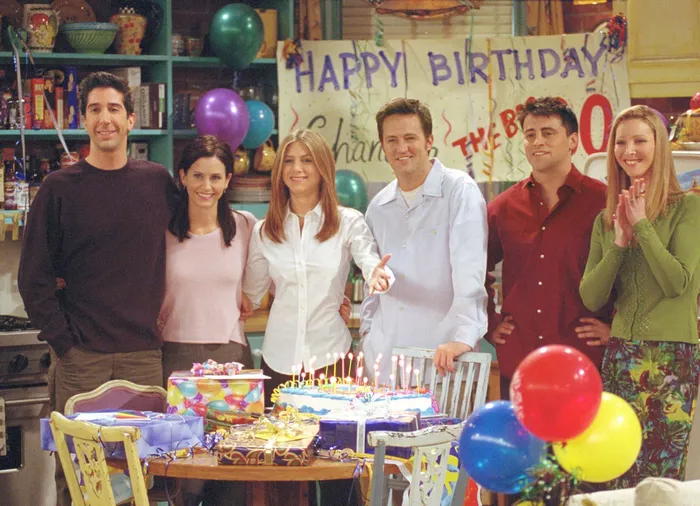The iconic show “Friends” holds a special place in the hearts of millions, its blend of humor, camaraderie, and relatable moments making it a cultural touchstone. However, beneath the surface of the seamless comedic timing, a new revelation from former screenwriter Patty Lin unveils a lesser-known aspect of the show’s dynamics. In her upcoming book, “End Credits: How I Broke Up With Hollywood,” Lin delves into the complex interactions between the show’s stars and its writers. A veil is lifted on a subtle tug-of-war that took place behind the scenes, one where humor sometimes took a back seat to creative clashes.
As the curtain rose on “Friends,” the spotlight shone brightly on the six main actors who brought the characters to life: Jennifer Aniston, Lisa Kudrow, Courteney Cox, Matt LeBlanc, Matthew Perry, and David Schwimmer. These names would become synonymous with the wit and charm of the show, but Patty Lin’s revelations offer an intriguing twist to this narrative. Lin, who was part of the writing team during the show’s seventh season, peels back the layers to expose a facet not commonly seen—the actors’ resistance to certain jokes.
Lin’s account paints a picture of actors who held the power to sway the course of a joke’s fate. In her own words, the actors would “deliberately tank” jokes that did not align with their preferences. This deliberate act created a ripple effect, forcing the writers to come up with multiple alternative versions of the jokes. This revelation adds a layer of complexity to the collaborative process behind the show, reminding us that even the most seemingly harmonious ensembles are not immune to creative differences.
Venturing into her reminiscences, Lin details the atmosphere that enveloped the show during her tenure. The excitement of working with acclaimed stars gradually gave way to a more subdued reality. The initial thrill of interacting with the renowned cast at table reads was replaced by a sense of disillusionment. Lin’s description of the actors’ demeanor paints a vivid picture of discontent, with the stars seemingly yearning to explore beyond the confines of the show. She writes, “The actors seemed unhappy to be chained to a tired old show when they could be branching out.” This sentiment unveils the duality of success—the public adulation for the show was paralleled by a sense of artistic confinement felt by the cast.
Lin’s revelations extend further, shedding light on the interactions between the cast and the creative team. She narrates the instances where jokes deemed unfavorable by the actors were derailed intentionally, leaving the writers with the task of crafting alternative punchlines. Lin’s depiction paints a picture of actors who were not merely executing their roles but actively shaping the narrative through their actions.
The table reads, which offered a glimpse into the actors’ perspectives, presented an interesting dynamic. Lin highlights the actors’ tendency to voice their concerns, often overshadowing the positive aspects of the scripts. The actors’ vocalizations often lacked viable solutions, painting a picture of passionate individuals fiercely guarding the integrity of their characters. Lin observes, “They rarely had anything positive to say, and when they brought up problems, they didn’t suggest feasible solutions.” This perspective highlights the intricate balance between actors who deeply embodied their roles and writers tasked with navigating the complex web of storytelling.
The creative clashes didn’t end at the table reads. Lin delves into the dynamics during run-throughs on set, offering insights into the actors’ assertive involvement in shaping the show’s direction. Lin’s description of these sessions highlights the challenges of reconciling the actors’ visions for their characters with the larger narrative arc. She notes, “Seeing themselves as guardians of their characters, they often argued that they would never do or say such-and-such.” This glimpse into the process underscores the fine line between artistic autonomy and collaborative storytelling.
Patty Lin’s insights remind us that the creation of iconic television shows is a delicate dance between various creative forces. The actors’ investment in their characters and their desire to shape the story intersect with the writers’ vision and the larger narrative canvas. The balance between creative autonomy and collaborative compromise becomes evident, shaping the final product that captivates audiences.
Lin’s journey within the realm of television writing spans beyond “Friends” to encompass a diverse array of shows, including “Freaks and Geeks,” “Desperate Housewives,” and “Breaking Bad.” “End Credits: How I Broke Up With Hollywood,” slated for release on August 29, serves as a memoir that provides a glimpse into a decade of navigating the intricate world of television scriptwriting. Through her experiences, Lin offers an introspective exploration of the creative landscape, offering a nuanced perspective on the intricate dynamics that drive the shows we cherish.
RELEATED READING:
-
Norman Reedus Unveils The Walking Dead: Daryl Dixon – A Canvas of Artistry and Evolution
-
Euphoria Season 3: Unveiling the Shadows of Change and Transformation
-
Nancy Drew’s Unseen Moments: Exploring the Untold Tale of Nancy and Ace
-
Riverdale’s Farewell: Unraveling the Closure of a Beloved Drama
-
Riverdale’s Unconventional Farewell: A Look at the Unexpected Ending

